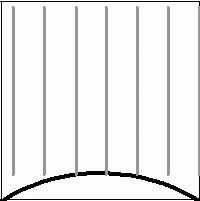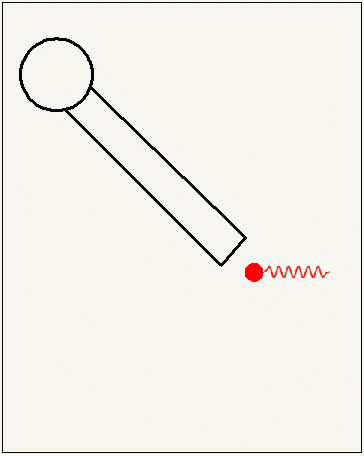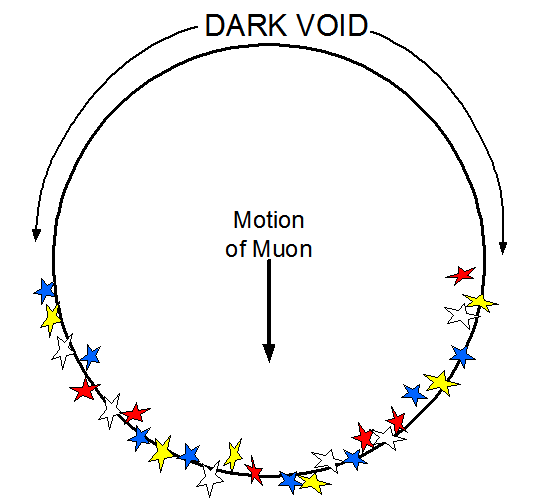:: Home
:: Sections :: Experiments
:: Blog :: Contact
::
This page posted on Nov 9, 2014, updated April 21, 2018
This page posted on Nov 9, 2014, updated April 21, 2018
View of the Universe from a muon's
perspective
This section is a
detailed exploration of how the muon sees the universe as it
moves near the speed of light when it is crashing into Earth
as described on section 2.1 of the main text. For the
purposes of this discussion, it is assumed that the pulsar is
a wideband pulse that has visible light for all observers.
A muon falling to Earth at near the speed of light is replicated here in the animation below. The muon is the blue dot falling down, a pulsar far, far away is sending pulses every 100 µsec depicted as waves traveling from right to left, and the muon’s life is extended from 2.2 µsec to about 500 µsec because of time dilation effects due to its relativistic speed.



For the muon the whole universe moves in the direction of its motion. For the muon the universe would look like this:

The muon sees all celestial objects moving to the front hemisphere of its motion. It sees behind a dark void hemisphere, where nothing seems to be there, except for a small region directly behind it that occupies the whole hemisphere. This is very much the opposite of what gets depicted on Science Fiction movies.
When time dilation and Doppler effects are taken into account, the stars directly in the direction of motion are severely blue shifted, but the blue shifting decreases as the angle from the direction of motion to the apparent position of the stars gets larger. For stars that seem near 90° from the muon’s motion, they will be red shifted, even when time dilation is taken into account. This effect is not shown in the images above.
The blue and red shifting occurs because the time that photons take to get across the telescope is not constant for all directions, that is, the speed of light is not constant, it depends on the direction where the light is coming from.
In this discussion, it is assumed that the muon does not experience any length contractions, and that its telescope remains optically good to see the stars. If we assume that the muon (and its telescope) experience length contractions, then the universe becomes much narrower and the needed telescope would give a new meaning to the expression ‘adaptive optics’.
The effects described above assume a muon moving at 0.99999c, but the effect is proportional to the speed of travel. At 0.9c, the dark void area is much smaller, not a whole hemisphere.
The implication of this effect clearly shows that the concept of relative motion is not sustainable, and neither is the concept of speed of light being constant for all observers regardless of their inertial state.
Here on Earth, we see stars in every direction of the sky, and the blue and red shifting that we sometimes observe on stellar objects, also happens in every direction; this implies that our motion thru space is relatively slow. Earth motion around the sun causes a small aberration of light coming from stars.
The discussion above is the classical way of looking at light aberration effects. The Theory of Relativity uses different formulas for calculating light aberration effects, and for small velocities, such as the velocity of Earth around the sun, there is not much difference between the two ways. At very high velocities such as the muon described above, the Theory of Relativity moves light from all the universe to within a few degrees of the front of the motion of the muon, resulting in a much narrower universe than the half hemisphere shown above. If two observers are moving at 0.99999c with respect to each other, Relativity tells us that at least one of them, or maybe both will see a narrow universe due to the aberration of light. This result is not consistent with the concept of relative motion. See a simulation of Relativity's effects in this youtube video posted by David Madore here.
The conclusion is that if you look around the universe from your point of view and you see stars all around, then you are nearly stationary, but if you see stars only on one area and not the others, then you are moving very fast thru space. Since the motion is with respect to space, then if follows that motion is absolute and not relative
A muon falling to Earth at near the speed of light is replicated here in the animation below. The muon is the blue dot falling down, a pulsar far, far away is sending pulses every 100 µsec depicted as waves traveling from right to left, and the muon’s life is extended from 2.2 µsec to about 500 µsec because of time dilation effects due to its relativistic speed.

For an Earth observer near the
area where the muon decays a telescope has to be pointed
to the 3:00 o’clock direction to observe the
pulsar. For the muon, however, a telescope has to
be pointed to the 4:30 of the clock direction to observe
the pulsar. See animation below.

The muon does not point its telescope as the Earth observer, it has to point it to the clock 4:30. While for the Earth observer the universe looks like the image below

For the muon the whole universe moves in the direction of its motion. For the muon the universe would look like this:

The muon sees all celestial objects moving to the front hemisphere of its motion. It sees behind a dark void hemisphere, where nothing seems to be there, except for a small region directly behind it that occupies the whole hemisphere. This is very much the opposite of what gets depicted on Science Fiction movies.
When time dilation and Doppler effects are taken into account, the stars directly in the direction of motion are severely blue shifted, but the blue shifting decreases as the angle from the direction of motion to the apparent position of the stars gets larger. For stars that seem near 90° from the muon’s motion, they will be red shifted, even when time dilation is taken into account. This effect is not shown in the images above.
The blue and red shifting occurs because the time that photons take to get across the telescope is not constant for all directions, that is, the speed of light is not constant, it depends on the direction where the light is coming from.
In this discussion, it is assumed that the muon does not experience any length contractions, and that its telescope remains optically good to see the stars. If we assume that the muon (and its telescope) experience length contractions, then the universe becomes much narrower and the needed telescope would give a new meaning to the expression ‘adaptive optics’.
The effects described above assume a muon moving at 0.99999c, but the effect is proportional to the speed of travel. At 0.9c, the dark void area is much smaller, not a whole hemisphere.
The implication of this effect clearly shows that the concept of relative motion is not sustainable, and neither is the concept of speed of light being constant for all observers regardless of their inertial state.
Here on Earth, we see stars in every direction of the sky, and the blue and red shifting that we sometimes observe on stellar objects, also happens in every direction; this implies that our motion thru space is relatively slow. Earth motion around the sun causes a small aberration of light coming from stars.
The discussion above is the classical way of looking at light aberration effects. The Theory of Relativity uses different formulas for calculating light aberration effects, and for small velocities, such as the velocity of Earth around the sun, there is not much difference between the two ways. At very high velocities such as the muon described above, the Theory of Relativity moves light from all the universe to within a few degrees of the front of the motion of the muon, resulting in a much narrower universe than the half hemisphere shown above. If two observers are moving at 0.99999c with respect to each other, Relativity tells us that at least one of them, or maybe both will see a narrow universe due to the aberration of light. This result is not consistent with the concept of relative motion. See a simulation of Relativity's effects in this youtube video posted by David Madore here.
The conclusion is that if you look around the universe from your point of view and you see stars all around, then you are nearly stationary, but if you see stars only on one area and not the others, then you are moving very fast thru space. Since the motion is with respect to space, then if follows that motion is absolute and not relative